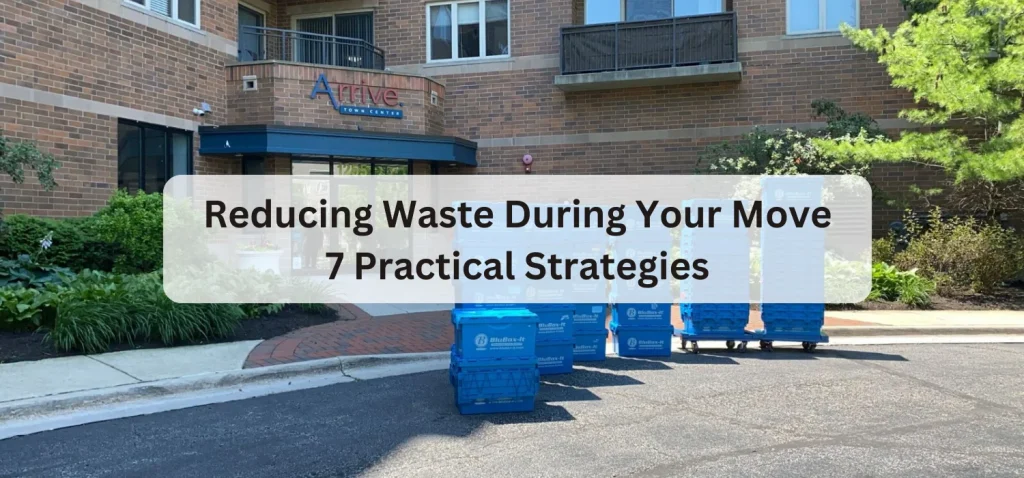But no, it does not have to be like that. With adequate determinations, you can move into a new house with little or no waste generated in the place and employ friendly strategies that do not have a negative impact on the environment. In this article, we will present some tips for reducing waste during your move. It will not only make the relocation cheaper but apso give it an environmentally friendly aspect.
7 Practical Strategies for Reducing Waste during Your Move
● Choose Reusable Moving Boxes over Cardboard
Reducing waste during a relocation is made easier by using reusable plastic moving boxes rather than ordinary, one-time use, cardboard boxes. Even though cardboard boxes serve their intentions, they are non-durable and most of the time they are only used one time after which they are thrown out or damaged. On the other hand, plastic moving boxes are reusable, can withstand rain, snow, and allow numerous moving of items thus promoting less trashing.
Additionally, plastic moving boxes are environmentally friendly because they assist in keeping away tons of cardboard from filling up the landfills. BluBox-It offers eco-friendly, recyclable, and strong boxes for short-term rental services, available in various sizes and sizes for various packaging needs.
● Clear Out the Clutter First Before Moving
Moving to a new place presents a golden opportunity to dispose of certain things, which you do not need anymore. Instead of simply packing everything in sight, you should take charge and declutter first before the move. Go from room to room and categorize your stuff as; keep, donate, recycle, or throw away.
As for the things, which are still usable, but do not have a place in your life anymore, you should think of giving them to some charity or shelter or community organization. Old clothes, furniture, kitchen gadgets or appliances, electronics can all be donated. Broken or unused items should be recycled or thrown away in a green manner.
● Make Use of Biodegradable Packing Materials
Ordinary packing materials such as styrofoam, plastic peanuts, and bubble wraps are damaging to the ecosystem. Their recyclability is very low, they take hundreds of years to break down and cause a lot of pollution. Thus, it is better to use more environmentally friendly materials that offer the same level of protection for your items but at no cost to the environment.
● Re-use or Dispose the Old Moving Supplies
If you had a chance to move in your life, you might have some extra moving items such as cardboard pads, bubble wraps or packing peanuts left over. Instead of just mindlessly tossing these things away, why not see if you can donate and use them out somewhere. There are several organizations that accept old moving boxes such as schools, community centers, or non profits. You can also ask your friends or neighbors whether they are moving soon and might need your leftover moving supplies.
If free recycling options aren’t available, consider small recycling options for soft plastic packages in your town. Most waste management garages now accept cardboard boxes and plastic wraps or bubbles. By recycling and reorganizing materials, you can work in a more environmentally friendly manner, reducing waste and promoting a more sustainable approach to waste management.
● Maximize Your Moving Efficiency
The environmental impact of waste is sometimes disregarded when planning a move, although the transportation of goods over vast distances contributes significantly to toxic effluent. Multiple back-and-forth excursions in cities waste fuel and emit pollutants. To mitigate these effects, travel should be planned in advance, with a drawing of the destination and everything packed into every spare inch of the vehicle or rental truck. Friends or family can assist by combining two or three cars into a single vehicle, avoiding wasted travel and environmental effects.
● Modify Everyday Objects to Use Them as Packing Material
Many people tend to go to the nearest convenience store to buy packing items. Instead of doing that, look around your house for materials that can serve the purpose of packing instead. You will be surprised by the number of things that you already have that are good enough to replace the buying of packing materials that are harmful to the environment.
● Make Use of an Eco-Friendly Moving Services
If you plan on getting professionals to help you move, you can consider picking a sustainable relocation company. Increasingly, moving services today are eco-friendly, for instance committed to the use of biodiesel trucks or providing reusable moving equipment and practicing waste minimization.
- An eco-friendly moving company will reduce the waste during relocation in the following ways:
- Instead of simple cardboard, they could provide reusable moving boxes which helps eliminate waste caused by packing materials.
- They may have strategies on minimizing operating fuel or carbon exceeding which is less likely.
- Such moving firms work with recycling facilities and cancellation of your items that are no longer needed to make sure that the waste is managed effectively.
Conclusion
From local move to long-distance, the crucial tips stated above, will help you in reducing waste, save the environment and make the move as eco-friendly as possible. The moving process may overwhelm people but with a little wish and planning, they can transform this crazy experience into a green project for them. After all, what would take few individuals to reduce waste is a giant leap for environmental conservation.

